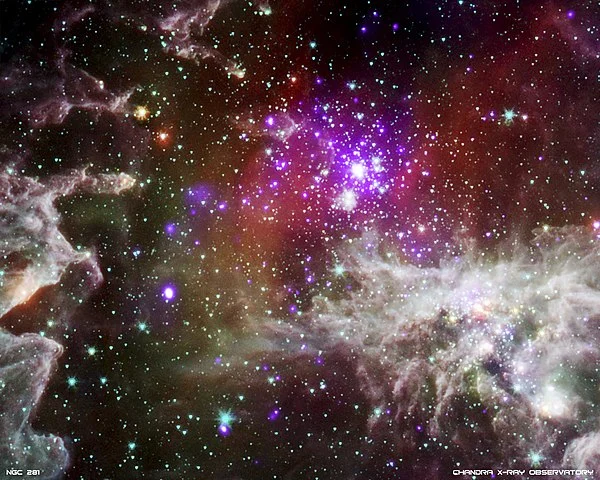Page 1 of 1
APOD: Stars and Dust in the Pacman Nebula (2024 Nov 18)
Posted: Mon Nov 18, 2024 5:05 am
by APOD Robot
 Stars and Dust in the Pacman Nebula
Explanation:
Stars and Dust in the Pacman Nebula
Explanation: Stars can create huge and intricate
dust sculptures from the dense and dark
molecular clouds from which they are born. The tools the stars use to carve their detailed works are
high energy light and fast
stellar winds. The heat they generate evaporates the dark molecular
dust as well as causing ambient
hydrogen gas to disperse and
glow.
Pictured here, a new open cluster of stars designated
IC 1590 is nearing completion around the intricate
interstellar dust structures in the emission nebula
NGC 281, dubbed the
Pac-man Nebula because of its
overall shape. The
dust cloud just above center is classified as a
Bok Globule as it may
gravitationally collapse and form a star -- or stars. The Pacman Nebula lies about 10,000
light years away toward the
constellation of Cassiopeia.
Re: APOD: Stars and Dust in the Pacman Nebula (2024 Nov 18)
Posted: Mon Nov 18, 2024 2:29 pm
by Ann
The Bok globules look like a pair of fetus on long umbilical cords in a very large womb!
Of course, you have to wonder what all those pillars along the rim of the womb are doing there - as if they were nosy onlookers like the hattifatteners in the
Moomin world!
Well, those pillars are really ubiquitous, whether they are hattifatteners or not!
In any case, the Pacman Nebula is a site of starbirth, so it is a kind of cosmic womb. Whether the Bok globules will give birth to stars is another matter. Maybe they will, maybe they won't. They look low mass to me.
On the other hand, Mrs. Pac: The big boy of your brood, HD 5005, is by all accounts a whopper! And he's got many other rascals in tow!
Ann
Re: APOD: Stars and Dust in the Pacman Nebula (2024 Nov 18)
Posted: Mon Nov 18, 2024 8:21 pm
by Bird_Man
I wonder what the night sky would look like if we were on a planet within the Pac-Man Nebula?
Re: APOD: Stars and Dust in the Pacman Nebula (2024 Nov 18)
Posted: Mon Nov 18, 2024 11:15 pm
by Chris Peterson
Bird_Man wrote: ↑Mon Nov 18, 2024 8:21 pm
I wonder what the night sky would look like if we were on a planet within the Pac-Man Nebula?
Probably similar to our own. The nebula would be invisible, so you'd just see stars. There would be a few really bright ones.
Re: APOD: Stars and Dust in the Pacman Nebula (2024 Nov 18)
Posted: Tue Nov 19, 2024 3:21 am
by harrystyles
Stars are born from dense molecular clouds, which provide the raw materials for their creation. As stars form, they emit high-energy light and fast stellar winds that shape the surrounding dust, creating intricate structures. The energy produced by stars heats the surrounding gas and dust, causing it to evaporate and glow, which enhances the visibility of these structures.
Re: APOD: Stars and Dust in the Pacman Nebula (2024 Nov 18)
Posted: Wed Nov 20, 2024 7:30 am
by Matthew23
The Pacman Nebula showcases the stunning interplay of stars and dust, illustrating how stellar activity shapes the cosmos from within.
 Stars and Dust in the Pacman Nebula
Stars and Dust in the Pacman Nebula



